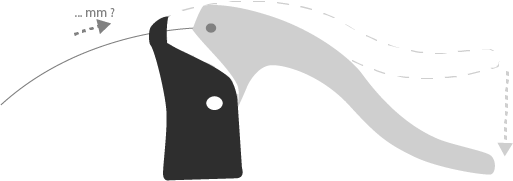Cable Pull
Many brakes and most derailleurs are actuated by pulling cables. Cable pull is how far the cable moves when the brake lever is pulled, or a shift lever is actuated.
For brakes, there are two main standards, short or conventional pull and long or V brake pull. Road bikes have tended to use short pull levers, although current Shimano road brakes operate on a slightly different cable pull than other brands. For mountain bikes, cable-actuated brakes have tended to use long pull. This means that mountain bike V-brakes will not work correctly with road levers and vice versa, although cable pull adapters may be available.
For indexed gears each groupset manufacturer will specify its own cable pull per shift (i.e. each click at the shifter), as well as how far the derailleur travels laterally per shift (i.e. the shift ratio or actuation ratio). Thus, shifters and derailleurs cannot generally be mixed across component manufacturers. Non-indexed (friction) shifters can generally be mixed, provided they have enough total cable pull.

